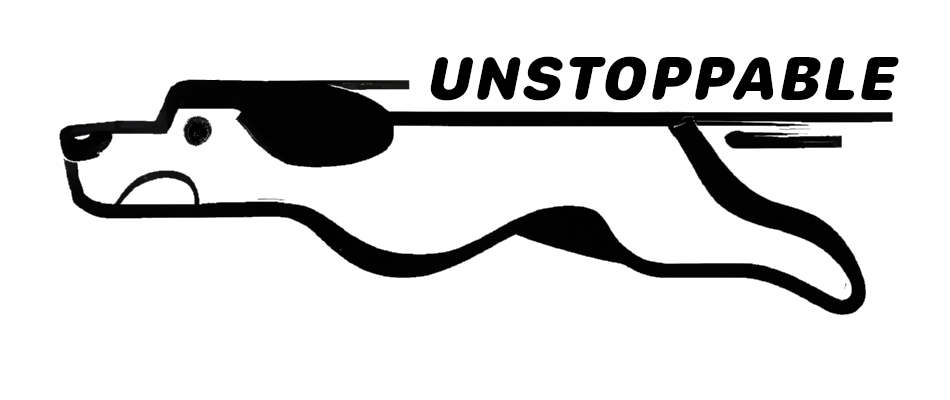The higher level you compete at, the more your choice of verbal cues matters. Do not wait until then to realize that your cues don’t serve their purpose. Re-teaching verbal cues is a hassle both for you and for your dog. Choose wisely ahead of time.
A good choice
To me a good verbal cue is:
- Easy to yell 🙂
- Easy to repeat
- One or two syllables long
- Considerably different than my other cues
A bad choice
My first cue for the right turn was “na“. When I started teaching my dog the exits from the dog walk I encountered a strange problem. Her left turns were perfect while her right turns… well… she regularly stopped in the middle of the upper plank. What?! It did not make any sense. It took me a while to realize that — as much as I carefully chose my agility cues — I did not consider the words I use in my daily life. The right turn cue sounded so similar to “no” (as in “no, stop doing that”) that every time I used it my dog thought she did something wrong and stopped. Lesson learned — take your non-agility cues into account as well.
How to vary
- Distinct sounds — some sounds are more pronounced than others (for example vowels). Don’t use the same sound in too many cues. Your dog will struggle trying to tell apart “bee” (let’s say it’s their name) from “weave”.
- Same sound but short or elongated — for example I use short repeated “in-in-in-in” for a threadle on the tunnel and one long “iiiiiiiiiiiin” for a threadle on the jump.
- Different intonation — you know how the pitch of the voice can raise and fall? It’s called an intonation contour. If one cue “goes up” and the other “goes down” it’s an additional detail that can help your dog distinguish them.
My cues
Here is a list of my cues (please bear in mind different handling styles use different sets of cues):
Obstacle cues
- Separate cues for dog walk, A-frame, see-saw, table, weave
- Same cue for standard jump, panel jump, viaduct jump, wall jump, tire (extension only)
- Broad jump, double jump, triple jump – right now I use the same cue as for standard jumps but I’m considering adding a “big jump” cue
- Backside of a jump away from me
- Backside of a jump toward me (jump threadle)
- Tunnel entry away from me
- Tunnel entry toward me (tunnel threadle)
Directional cues
- Left and right turns
- Left and right jump wraps — my cues are absolute as they work better with my handling, some people use relative cues which depend on where the handler is at that moment (wrap toward me, wrap away from me)
- Come to hand — run toward me ignoring everything else
- Long straight line —for taking obvious obstacles in a fairly straight line (do not use on easily excitable fast dogs, inevitably results in dropped bars 🙂)
- Continue straight despite uncertainty — continue straight while the obstacle to be taken is not yet obvious, or continue straight in spite of handler being far behind
Other cues
- Stay
- Release
- Continue weaving — I have a separate cue for entering the weave and for weaving
- Get your toy/cookie — I use a separate cue for toy vs treats
- Speak (as a happy behavior) — barking before the run helps my Golden to focus, hence it became an “agility cue”
- Jump into my hands
- Positive/negative markers — I use “yes” and “oh-oh”
- All done — we’re finished, go do whatever your heart desires

Really appreciate this post. It’s filled with so much useful information and yet it’s a concise read. The most interesting new thing I learned is using the same sound but short or elongated form to distinguish different cues. Never thought about this before, but would be great to try it out with my dog.
I do have a question – can you elaborate a bit more on what’s the difference between your “Long straight line” cue and “Continue straight despite uncertainty” cue? They seem to mean the same thing to me 🙂
Thank you, Shu!
“Long straight line”:
Any straight lines where I’m ahead or at least next to my dog. It basically means “run as fast as you can, there will be no collection needed for a while”.
“Continue straight”:
Any straight lines where I’m behind. Being behind naturally cues collection and curves the dog’s path toward the handler. In this case it means “ignore that I’m behind, keep going straight”. Useful if you need to babysit something (a backside or an obstacle discrimination) just before a straight line of jumps, so you loose your lead out. Also for any games with lines that you cannot cross.
OR
When I’m behind (so I can’t support my dog) and I need them to do one more stride to see the next obstacle. Imagine two straight tunnels, parallel, and a dog coming at 90 degrees toward the entrance of the first one. The dog doesn’t see the other tunnel until it passes the first one. In this case the cue means “ignore that tunnel, keep going straight even though you don’t see any other obstacles”.